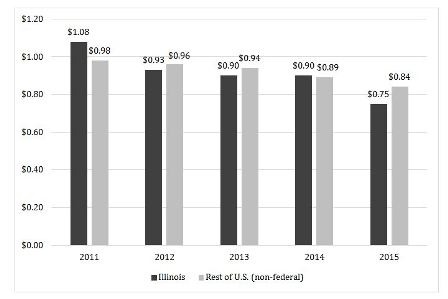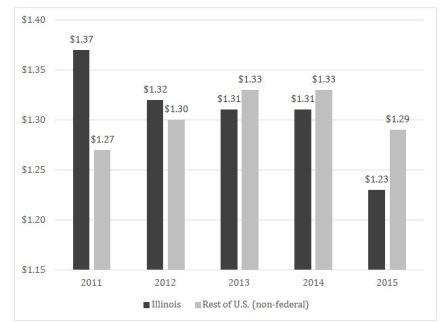For Immediate Release | October 5, 2017
WASHINGTON, D.C. – In Illinois, workers’ compensation benefits paid dropped sharply in recent years compared to the rest of the U.S., according to a new report from the National Academy of Social Insurance (the Academy).
In 2015, workers’ compensation benefits paid in Illinois were $2.4 billion. Between 2011 and 2015, Illinois experienced a 19.3 percent decrease in benefits paid, the second largest decrease across the country. Total benefits paid in the rest of the U.S. increased by 2 percent over the same period (Table 1). According to the report, Workers’ Compensation: Benefits, Coverage, and Costs, the large decrease in total benefits paid in Illinois is most likely attributable to a number of changes implemented in 2011 that regulated the medical delivery system.
“Illinois reduced its medical fee schedule by 30 percent, established a preferred provider program, and introduced a number of other changes to its medical system in 2011 that are likely influencing the decline in medical benefits paid,” said Christopher McLaren, Senior Researcher at the Academy and lead author of the report. “There were also legislative changes to statutory benefit levels and disability rating standards that explain some of the trends in cash benefits paid in the state.”
In Illinois, both medical and cash benefits decreased between 2011 and 2015, but the percentage decrease in medical benefits was 50 percent greater than the decrease in cash benefits (-23.3 percent vs. -15.6 percent). As a result, medical benefits as a share of total benefits paid in the state fell from 47.7 percent in 2011 to 45.3 percent in 2015. Among all states, Illinois had the seventh lowest percentage share of medical benefits relative to total benefits paid in 2015.
Illinois also experienced slower growth in employer costs for workers’ compensation relative to other states. Between 2011 and 2015, costs in Illinois increased 3.8 percent, well below the 21.6 percent increase in costs that occurred in the rest of the U.S.
Table 1. Workers’ Compensation Benefits, Coverage, and Costs:
Illinois and the Rest of the U.S.
|
2015 |
Percent Change 2011 to 2015 |
|||
|
IL |
Rest of U.S. |
IL |
Rest of U.S. |
|
| Aggregate Benefits, Coverage, and Costs | ||||
| Total Benefits (billions) |
$2.4 |
$55.7 |
-19.3% |
2.0% |
|
Medical Benefits |
$1.1 |
$28.8 |
-23.3% |
1.9% |
|
Cash Benefits |
$1.3 |
$26.9 |
-15.6% |
2.0% |
| Covered Workers (thousands) |
5,754 |
127,083 |
5.2% |
8.1% |
| Covered Payroll (billions) |
$320 |
$6,652 |
16.0% |
19.4% |
| Employer Costs (billions) |
$3.9 |
$86.0 |
3.8% |
21.6% |
Workers’ compensation, the nation’s first social insurance program, pays medical benefits to the providers of health care for injured workers, and cash benefits to workers whose injuries prevent them from working. Much of the interstate variation in benefit payments and employer costs can be attributed to different trends in employment and wages across states, rather than to structural differences in state workers’ compensation systems.
“The trends in workers’ compensation benefits and costs in Illinois between 2011 and 2015 have made a dramatic change in how Illinois compares to other states,” said Marjorie Baldwin, Professor at Arizona State University and co-author of the report. “In 2011, workers’ compensation benefits paid per $100 covered wages were 10 percent higher in Illinois than in the rest of the U.S.; in 2015 they were 13 percent lower. Costs to employers (per $100 covered wages) were 8 percent higher in Illinois in 2011; in 2015 they were 5 percent lower.”
Other findings on workers’ compensation in Illinois from the Academy’s report include:
- Increases in employment and payroll covered by workers’ compensation were slightly below the growth in the rest of the nation. In 2015, covered employment reached 5.8 million in Illinois, up 5.2 percent from 2011 (compared to an 8.1 percent increase for all other states), and covered payroll was $320 billion, up 16 percent from 2011 (compared to a 19.4 percent increase for all other states).
- Workers’ compensation benefits paid in Illinois declined as a share of payroll to $0.75 per $100 of covered payroll in 2015, down from $1.08 in 2011 (Figure 1). Illinois experienced the third largest decline in benefits as a share of payroll among all states during that period. Benefits as a share of payroll declined in the rest of the U.S., but at a much more gradual pace.
Figure 1. Workers’ Compensation Benefits per $100 of Covered Payroll, 2011-2015: Illinois and the Rest of the U.S. (non-federal)

- Costs as a share of payroll in Illinois decreased from $1.37 in 2011 to $1.23 in 2015 (Figure 2).While costs as a share of payroll in Illinois were higher than the rest of the country in 2011 ($1.37 vs. $1.27), they fell below the rest of the country in 2015 ($1.23 vs. $1.29).Illinois experienced the eleventh largest decline in costs as a share of payroll between 2011 and 2015.
Figure 2. Workers’ Compensation Costs per $100 of Covered Payroll, 2011-2015: Illinois and the Rest of the U.S. (non-federal)

Workers’ Compensation: Benefits, Coverage, and Costs (2015 data) is the 20th in an annual series. The report provides the only comprehensive data on workers’ compensation benefits, coverage, and costs for the nation, the states, the District of Columbia, and federal programs.
EXPERTS TO CONTACT:
| Christopher McLaren National Academy of Social Insurance (202) 243-7280cmclaren@nasi.org |
Marjorie Baldwin
Arizona State University |
The National Academy of Social Insurance is a non-profit, nonpartisan organization made up of the nation’s leading experts on social insurance. Its mission is to advance solutions to challenges facing the nation by increasing public understanding of how social insurance contributes to economic security.
See related news: Disability, Workers' Compensation, Workforce Issues and Employee Benefits
